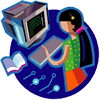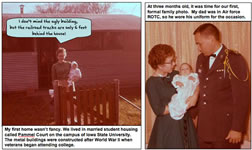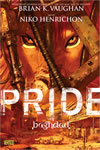Comics & Graphic Novels

The Basics
Cartoons. A cartoon is a full-size drawing. Balloons may be used to depict speech and a caption is sometimes found across the bottom of the visual. These works of art are often humorous. Editoral cartoons are funny but often have a serious tone using irony or satire.
Comics. Comics, comic strips, and comic books contain a series of cartoon illustrations that tell a story. Presented in a sequence, comics may be a few panels or many pages. Read the original Spider-Man comic at Marvel.
Digital or Web Comics. Comics that are designed specifically to be shared electronically are called digital or webcomics. Many web comics eventually become popular print comics.
- Children
- Young Adults
- Clive and Cabbage - Alien Safari (Kazu Kibuishi) - entire comic
- The Dreamland Chronicles
- The Phoenix Requiem
- Smith Mag
Graphic Novels. Graphic novels are a more lengthy version of a comic book. They usually have a more complex storyline than a traditional comic. Although many are for mature audiences, an increasing number are being produced for young people. Many books are also available as graphic novels. For instance, Artemis Fowl by Eoin Colfer is available as both a traditional novel and a graphic novel. Coraline is another example.
Manga. Manga is Japanese for comic or whimsical pictures. The format is often associated with a particular style of drawing, but can be applied to a wide range of Japanese comics. Manga are typically read from top to bottom and right to left. Manga produced by Viz media is particularly popular with young people. They produce materials for both boys and girls of various ages such as Beyblade, Medabots, MegaMan, and Pokemon. Other producers include Tokyopop, CPM Press, ADV Manga, and Dark Horse.
 Illustrated Novels. Incorporates visuals into fiction books such as The Invention of Hugo Cabret by Brian Selznick and The Selected Works of T.S. Spivet by Reif Larson.
Illustrated Novels. Incorporates visuals into fiction books such as The Invention of Hugo Cabret by Brian Selznick and The Selected Works of T.S. Spivet by Reif Larson.
Graphic Textbooks. Check out examples from my Graphic Textbook coming out in 2011 called Graphic Inquiry.
Information Graphics. Presents news and information visually such as Financial Meltdown Example. Check out the work of Tonia Cowan.
Sequential Art. The category of illustration that includes cartoons, comics, graphic novels, and manga is called sequential art.
Babymouse does a nice job explaining graphic novels and comics to young people.
Read Understanding Comics and Making Comics by Scott McCloud to learn more about the language of sequential art.
The Comic Boom
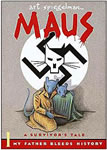 Having grown up reading comic books like The Archies and magazines such as Mad, I've wondered about the recent surge in popularity of this format. Why now?
Having grown up reading comic books like The Archies and magazines such as Mad, I've wondered about the recent surge in popularity of this format. Why now?
Multimedia Tie-ins. From Spiderman to X-Men and Iron Man, traditional comics are being tied to video games and hit movies.
Major Awards. Graphic novels have begun to win major awards for both adults and young people. Maus: A Survivor's Tale Volume 1: My Father Bleeds History by Art Spiegelman got the ball rolling in terms of awards for adult publishing. Read the Teacher's Guide. Then, American Born Chinese by Gene Luen Yang won literary awards for young adult literature such as the 2007 Michael L. Printz Award.
Japanese Influence. Manga is a hit with young people. American children are wild about Japanese cartoons, comics, and graphic novels. Many companies such as Toyopop have a Kids Manga section.
Notable Authors. With the introduction of Stephen King's Dark Towerin a graphic novel format, mainstream authors are beginning to see the role of graphic novels in the publishing industry. The Young James Bond is coming out in graphic novel format.
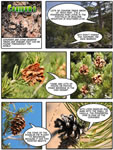 Timely Topics. Graphic novels such as Persepolis and Pride of Bagdad have brought world topics to the forefront. The 9/11 Report: A Graphic Adaptation provides an accessible alternative to the Commission report. Also check out In the Shadow of No Towers by Art Spiegelman.
Timely Topics. Graphic novels such as Persepolis and Pride of Bagdad have brought world topics to the forefront. The 9/11 Report: A Graphic Adaptation provides an accessible alternative to the Commission report. Also check out In the Shadow of No Towers by Art Spiegelman.
Child-Centered. Go to the BoltCity website and you'll find both webcomics and links to print comics and graphic novels for all ages.
Comic Life. Easy-to-use tools such as Comic Life have made it easy for anyone to create their own, high-quality comic. Check out the Conifers example.
![]() If you're selecting materials for young people, look for labels. Many will indicate that they are for ALL AGES or just for MATURE AUDIENCES. Manga books sometimes use the following system: A for all ages, Y for youth, T for teen, OT for ages 16 and up, and M Mature 18+.
If you're selecting materials for young people, look for labels. Many will indicate that they are for ALL AGES or just for MATURE AUDIENCES. Manga books sometimes use the following system: A for all ages, Y for youth, T for teen, OT for ages 16 and up, and M Mature 18+.
Comics and Graphic Novels in Teaching and Learning
 From Beowulf illustrated by Gareth Hinds to Treasure Island, the possibilities for the classroom are endless. Why study graphic novels?
From Beowulf illustrated by Gareth Hinds to Treasure Island, the possibilities for the classroom are endless. Why study graphic novels?
Read Bone: Out of Boneville by Jeff Smith. Check out the Scholastic Discssion Guide (PDF) or (Text). For more information, go to Scholastic Bone page. Explore some of the Scholastic Graphix books.
Try It! Use Scholastic Comic Makers
Use at least one of the following Scholastic tools for creating comics:
Amulet
Bone
Charlotte's Web
A Dog's Life
Goosebumps
Hugo Cabret
Smile
Think about lessons that might involve creating a Story Train (PDF) or Problem and Solution (PDF).
There are many ways to use comics and graphic novels in teaching and learning. Here are some ideas:
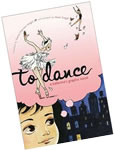 Autobiographical Connections
Autobiographical Connections
Read To Dance : A Ballerina's Graphic Novel by Siena Cherson Siegel, Mark Siegel (Illustrator) (Age 12+). This graphic novel focuses on the life of a young dancer.
Use The Magical Life of Long Tack Sam by Ann Marie Fleming as an example of an illustrated memoir. Based on a documentary, this work contains a wide variety of images from hand drawings to screen shots from videos. Examine a page from the book and notice how historical photos and other images are used. Also example a page with still images from the documentary.
Kampung Boy by Lat explores culture and change growing up in Southeast Asia during the 1950s.
The Wall: Growing up Behind the Curtain by Peter Sis focuses on growing up behind the iron curtain.
Pyongyang by Guy Delisle is a non-fiction account of the author's travels in North Korea. Involve students in writing accounts of their own experiences traveling.
When writing autobiographies in the classroom, consider sequential art as an alternative to traditional approaches. Encourage young people to incorporate a mixture of visuals including art from their childhood, photographs, scanned documents, and other graphic elements.
Rather than writing a report on a famous person, write a graphic novel! Incorporate original drawings and primary source documents including photographs; birth, death, and marriage certificates; scanned tickets, newspaper clippings, and other materials. Work with the location historical society to explore famous local or state personalities. Go to Laura Wilson as an example.
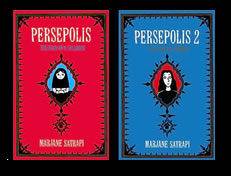 Read Persepolis: The Story of a Childhood and Persepolis 2: The Story of a Return by Marjane Satrapi. This memoir describes the life of a girl growing up in Iran during the Islamic Revolution.
Read Persepolis: The Story of a Childhood and Persepolis 2: The Story of a Return by Marjane Satrapi. This memoir describes the life of a girl growing up in Iran during the Islamic Revolution.
Examine the Lesson and adapted WebQuest (Grades 11-12). Students will use the BioCube to outline their role and use Comic Life software to create a graphic journal. Finally, they share on a class wikispace.
There are many other ways to focus on people in a comic project:
- Create a class "hero" biography that includes a chapter on heros in each students' life.
Biography Connections
Use graphic novels as a way to explore the lives of people throughout history. Read biographies from The Center for Cartoon Studies including Houdini: The Handcuff King by Jason Lutes & Nick Bertozzi, Satchel Paige: Striking Out Jim Crow by James Sturm and Rich Tommaso and Thoreau at Walden by John Porcellino.
 Fiction Connections
Fiction Connections
Read Mouse Guard by David Petersen (Middle School +). Use the Mouse Guard website to focus on characters, plot, and setting. Also, check out the author's blog. Keep your own blog as you think about the characters, plot, and setting for your graphic novel.
Use a tool like Wikispaces to share your thoughts on characters, plot, and settings. For instance, you might create a comic page that explores the different visual representations of character, plot, and/or setting. Can you envision the setting for Tuck Everlasting? Why are there so many different images of Beowolf? If you'd like a space to share your project, I've set up a wikispace called Characters in Literature. You can add pages and information about the characters you explore, analyze, or create.
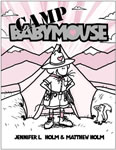 There's also a page started for Settings in Literature where you can share your thoughts on the settings in existing books or stories you're writing. Read a traditional book. What would the book look like if it were turned into a graphic novel? What colors would be used? Would you use line drawings or photographs? Write about it, then create a sample page from your graphic novel.
There's also a page started for Settings in Literature where you can share your thoughts on the settings in existing books or stories you're writing. Read a traditional book. What would the book look like if it were turned into a graphic novel? What colors would be used? Would you use line drawings or photographs? Write about it, then create a sample page from your graphic novel.
Also get young people involved in writing their own books or extend existing books. Read a book from the Babymouse graphic novel series by Jennifer L. Holm. Consider the following projects:
- Write a story based on a character in your favorite book.
- Write another chapter for a book.
- Write an alternative ending to your book.
- Write a totally new story based on your personal experiences.
Short Story Connections
Many comics series are compiled into short story collections. In the case of Flight, the collection focuses on the theme of flight.
The Eternal Smile (3 short stories) by Gene Luen Yang and Derek Kirk Kim
Use Postcards: True Stories that Never Happened edited by Jason Rodrigez to jumpstart an illuminated project based on postcards. Ask young people to develop a story based on a postcard. Go to the book website to learn more about it and see examples from the book.
Social Issues Connections
Read the award winning graphic novel: Pride of Bagdad by Brian K. Vaughan. Write your own graphic novel set in Baghdad. Write from the perspective of someone who experienced the bombing of Bagdad. Go to Bombs and Barbed Wire in Baghdad for an example.
Historical Connections
Read Berlin, Book One: City of Stones by Jason Lutes and Berlin, Book Two: City of Smoke by Jason Lutes to explore life in the 1920s and 1930s before WWII.
Still I Rise: A Cartoon History of African Americans by Roland Owen Laird and Elihu Bey explores the struggles of African American through history.
Read The Arrival by Shaun Tan. This wordless book focuses on the experiences of an immigrant. Many examples pages are at the author's website. You can also read an article by the author about his techniques. How well does it convey its message? What's real and what's fantasy? Compare images of the immigrant experience with the visuals in the story. Go to Scholastic for lots of ideas for immigration projects such as the oral history project.Invent a family based on immigrant photos of the time period. View a sample page created in Comic Life.
- Selected Images of Ellis Island and Immigration (1880-1920) from Library of Congress (immigration stations, discharge, immigrants)
- Photo Album from Ellis Island Foundation
Other Resources
- Ellis Island Foundation
- Immigration: The Changing Face of America from Library of Congress
- Immigration: Learning Page from Library of Congress
Read Hot Iron: The Adventures of a Civil War Powder Boy by Michael Burgan from Stone Arch Books. With a reading level of grades 2 and 3 but an interest level of grades 3 to 6, this book would be a good alternative for a child who might not be successful reading other Civil War novels for young people. Using it as an example, ask students to create a comic for one chapter of their book. Use photographs from the Library of Congress as a starting point. Be sure to check the Selected Civil War Photographs page.
Classics Connections
 Some people have observed that graphic novels bring the classic works of literature to a new audience. Others say that these works are fakes and a poor alternative to the original versions. What do you think?
Some people have observed that graphic novels bring the classic works of literature to a new audience. Others say that these works are fakes and a poor alternative to the original versions. What do you think?
Read Beowolf or Treasure Island by Robert Louis Stevenson (retold by Wim Coleman and Pat Perrin) from Stone Arch Books in the graphic novel format. Compare the visual version to the text version. How do they compare? Which do you prefer? Why? What do you gain and lose betwen the two formats?
Go to Teacher Tap: Electronic Books for books you can read online such as Treasure Island and The Odyssey.
Content Area Connections
Read Cartoon History of the Modern World by Larry Gonick and Woollcott Smith.
There are an increasing number of nonfiction comic books and graphic novels. From Chemistry to Statistics, you can find lots of examples to use as models. Get your students involved with writing a class book. Each student is in charge of writing a couple pages that can be used as a review of the topic. Consider an assignment that incorporates facts with a fictional account of a real event such as a natural disaster. Or, ask students to write a preparation plan for a natural disaster in the comic format. Rather than everyone doing the same thing, let students choose their earth science topic. Provide a few starter visuals. For instance, you might provide the DK Earth Science clipart page. Students could mix their own drawing with photographs and visuals.
Also use goverment resources such as the NOAA or USGS website. For instance, ask students to write about an environmental hazard. Rather than a traditional report, create a comic. Using PowerPoint, create the comic in the slide area. Then use the Speakernotes for additional information, facts, questions and answers, citations, and other information. You can print it as a comic book, or you can print each page with the speakernotes. One student did a project on Abandoned Mine sites using the USGS photos.
Wordless Books
Use wordless books such as Full Moon Soup by Alastair Graham for inspiration. Use them to talk about what's happening in the pictures. Use the links below for lists of wordless books:
- Wordless Picture Books
- Wordless and Nearly Wordless Books from Allen County Public Library
- Wordless Picture Books from the Louisville Free Public Library
Try It! Brainstorm Classroom Connections
How will you integrate graphic novels and visual resources into your classroom. Brainstorm the possibilities.
Creating Comics in the Classroom
As you develop assignments that incorporate comics, think about the wide variety of graphic elements that could be integrated.
Before jumping into the creation of your own comics, do some exploring and evalute the work of others. Go to the Cartoon Analysis Worksheet from the National Archives. Use this page to analyze comics.
Copyright Issues and Comic Creation
You can find lots of drawings, photos, and other graphics online. Before you use the photos, check the copyright restrictions. In most cases you can use them for educational purposes as long as you aren't reposting or selling them. If you plan to put them on a website, read the rules carefully. It's okay to use materials that are distributed as part of a media packet from a publisher. They often provide a book cover and one interior page. Below you see a photo from the CDC Image Library. Use these in a project on West Nile Virus.

For high school leve (mature students only), read a historical graphic novel such as the popular 300 by Frank Miller. The Battle of Thermopylae was a significant event in ancient world history. The Spartan King Leonidas and his 300-man bodyguard fought the massive army of Emperor Xerxes of Persia. The Spartans were destroyed. Is the novel based on fact or fiction? Research the authenticity of the storyline. Use tools like Wikipedia to gather resources in the public domain that students can use.
 Photographs and Comics
Photographs and Comics
You don't need lots of photographs for a successful project. Lois Lowry wrote an entire novel called The Silent Boy based on a single photograph! This book isn't a graphic novel, but it does incorporate a historical photo at the beginning of each chapter to get you thinking about the characters, plot, and setting.
Government websites are one of the best places to go for photos.
- CalPhotos
- Earth Science Photos
- Fish and Wildlife Photos
- Pics 4 Learning
- USGS Photo Collection - astrogeology, biology, ecosystems, geology, geography, water, national parks
- CDC Image Library
- FirstGov Photos and Graphics
- Library of Congress (Prints and Photographs)
- NASA Digital Image Collection
- National Archives Exhibits
- NOAA Photo Library
- Teacher Tap: Visual Resources
- Public Domain and Copyright-Free Sites
If you're looking for historical photographs, consider the Prints & Photographs Online Catalog from the Library of Congress.
Analyze photographs for elements that tell about the person or character you wish to develop. Use The Mill Girl from the Library of Congress collection as an example. How many different views can you find in a single photo? What if you zoom in or zoom out? What if you flip the photo or turn it? Can you tell an entire short story with a single historical photo? Use graphic software to modify the photos.
Go to the NOAA Photo Library. Examine one photo or a series of photos in-depth to tell a story about a science topic. Go to National Oceanic and Atmospheric Administration/Department of Commerce, NOAA's Coral Kingdom Collection (reef0508) for an example of a diver.
Remember that you can photograph all kinds of objects from airline tickets to birth certificates. Remember to remove credit card numbers, social security numbers or other personal information first. You can even use graphics software to create your own fictional documents.
Explore your graphics software. Try some of the following ideas:
- Take a color photo and turn it black and white. Tell a historical story using new photos you've made back and white.


- Take photos from different angles. Tell the story of a house using photos from many different angles.

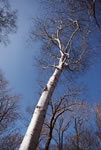
Consider historical collections and primary source materials. For instance, go to the Library of Congress and search for 1918 flu.
When you go on a field trip, you need to proceed with a mission. Rather than taking snapshots. Look for closeups, distance shots, interesting angles that would be fun for a comic project. Explore the Field Trip: Pawhaten Village 1607 example.
Clip Art
Explore clipart online
- Awesome Clipart for Educator (lots of annoying ads)
- Cartoons and Color Pages
- Classroom Clipart (lots of annoying ads)
- Discovery School
- DK Clip Art
- Microsoft Office Clipart
- Open Clipart
Use the DK vacation clipart to create a story about the vacation of your dreams!
You could write about the life of a rock. Start with the DK earth science section. Then add your own photos of rocks.
Use the Discovery School clipart for a health and safety activity.
Original Art
From sketches to sculptures, you can take photographs or scan original works of art. Examine Ode to a Cabin. It contains original photos and sketches.
Many popular novels for young people are incorporating drawings. Some of these are graphic novels and others are just illustrated books. Check out The Diary of a Wimpy Kid: A Novel in Cartoons by Jeff Kinney, The Absolutely True Diary of a Part-Time Indian by Sherman Alexie and The Invention of Hugo Cabret by Brian Selznick.



Charts and Graphs
Create your own charts and graphs using computer software or online tools. You can also integrate screen shots from online games and other websites. These are particularly useful if students are doing critical reviews. For instance, ask students to review an online game, then write about how they would change it to make it more effective.
Techniques
Students need practice in building effective activities. Go to the National Archives Exhibits and choose an historical event.
- Thinking - persuade, debate, (use escrapbooking)
- Sequential Assignments - biography, science experiment, events in history, events in book
- Ensure Depth of Thinking
- Add citations, FAQs, 1 page overview with comic
- Create audio to go with comic
- Bubble Projects
- Screen shots and bubbles (Write about process in Interactive)
- Interactives
- Website articles (Sports section... point out stats, descriptions)
- Screen shots and bubbles (Write about process in Interactive)
Try It! Tell a Visual Story with One Image
Use a single photo to tell a story in Comic Life. Use the links above to locate sources of images.
